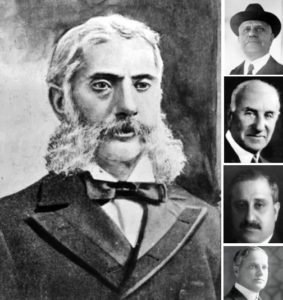
Meyer Guggenheim, with (top to bottom) Daniel, Solomon, Simon, and Benjamin
Meyer Guggenheim (1828-1905) was born in Switzerland to a traditional Ashkenazi Jewish family. At 19, he set out on his own and journeyed to the United States. After working in various shops in Philadelphia, Guggenheim opened up his own company, importing Swiss embroidery. Business went well, and he soon searched for new opportunities. In 1881, Guggenheim invested $5000 in two Colorado silver mines, and quickly realized their incredible potential. He sold all his other ventures and put all of his money into mining and smelting. With the help of his seven sons, Guggenheim quickly expanded across the US. By 1901, the family controlled the largest metal-processing plants in the US, and also owned mines in Mexico, Bolivia, Chile, and the Congo. In 1922, various disputes led to the Guggenheims being kicked out of their largest company by its own board. Soon, they sold off all of their mines. The family would invest elsewhere, and the fortune vacillated over the decades. In 1999, it ceased to be a strictly family affair with the opening of Guggenheim Partners. Today, the firm has 2300 employees, and controls $260 billion in assets worldwide (including the Los Angeles Dodgers baseball team, purchased for a record $2.15 billion in cash).
After the elder Guggenheim’s passing, his son Daniel Guggenheim (1856-1930) took over the business. By 1918, he raised the family fortune to as much as $300 million, making them among the wealthiest people in the world, as well as among the most generous philanthropists. Daniel’s son was a World War I pilot, inspiring Daniel to invest considerably in aviation technology. To this day, the most prestigious prize in aeronautics is the Daniel Guggenheim Medal. Another son, Solomon Guggenheim (1861-1949), was a patron of the arts and an avid collector. He established New York’s world-famous Guggenheim Museum. Meanwhile, Simon Guggenheim (1867-1941) served as a US senator. He established a fund in honour of his deceased son that has granted over 15,000 scholarships to date, totalling over $250 million! His $80,000 donation (equivalent to $2.5 million today) to a Colorado school was, at the time, the largest private grant ever made to a state institution. Benjamin Guggenheim (1865-1912) worked for the family business out of Paris, and in 1912 boarded the Titanic to head back home. When the iceberg hit, he was offered a place among the first women being evacuated, but rejected, saying “No woman shall remain unsaved because I was a coward.” One survivor reported that “after having helped the rescue of women and children, [he] got dressed, a rose at his buttonhole, to die.” His body was never recovered.
Words of the Week
We can easily forgive a child who is afraid of the dark; the real tragedy of life is when men are afraid of the light.
– Plato

